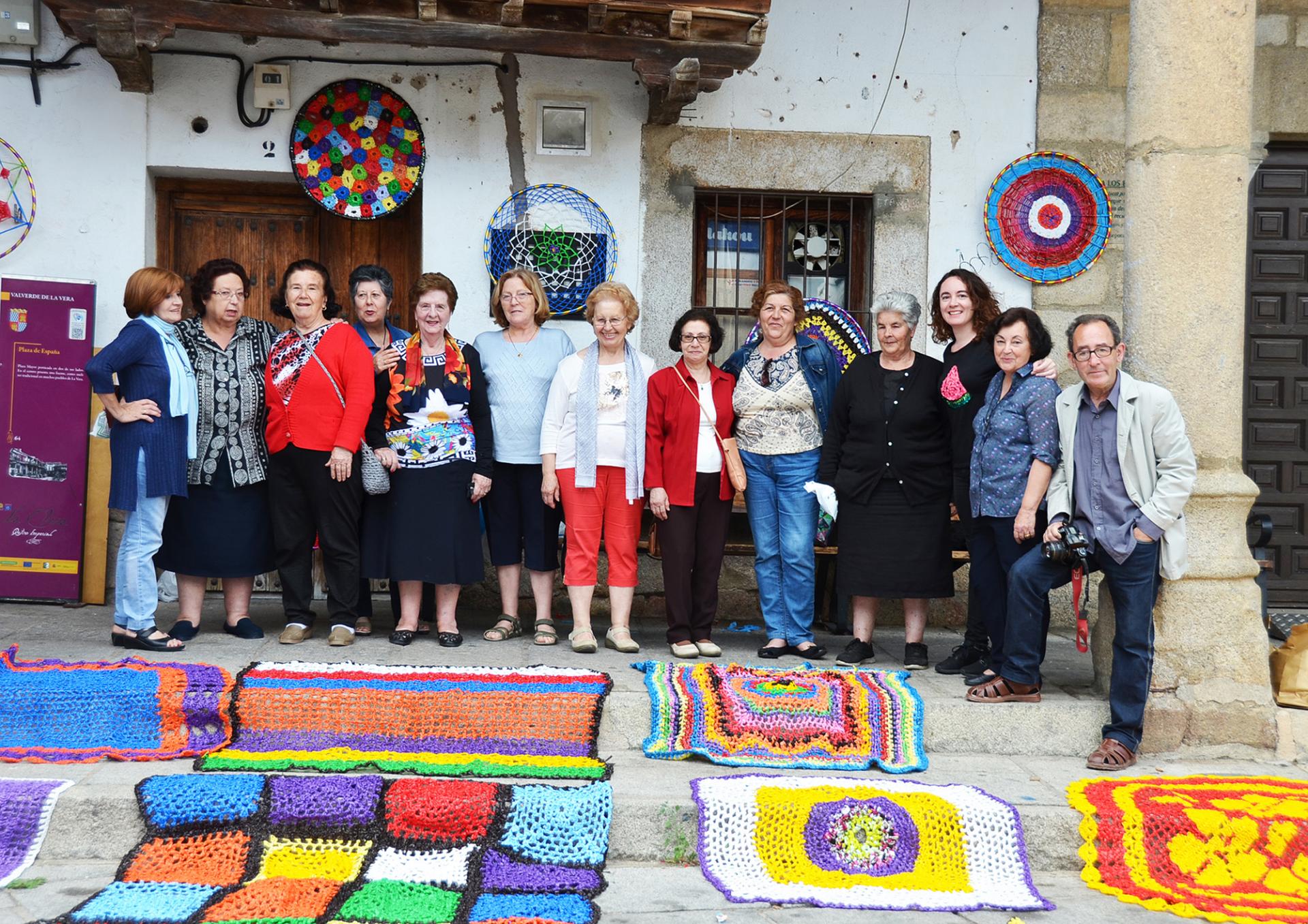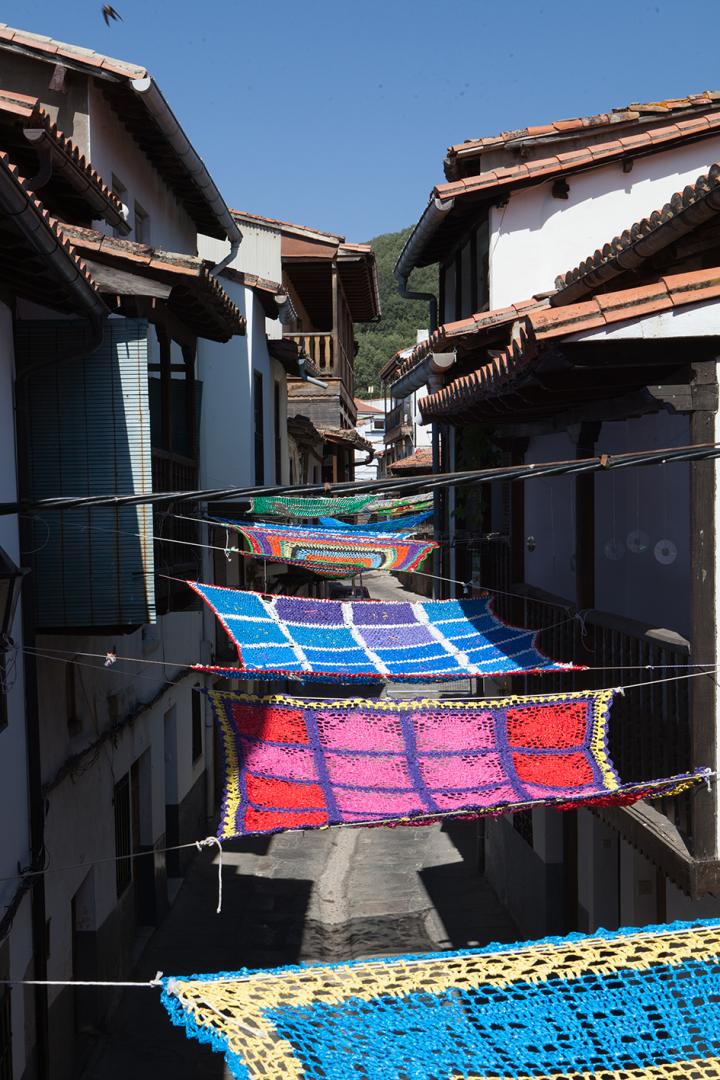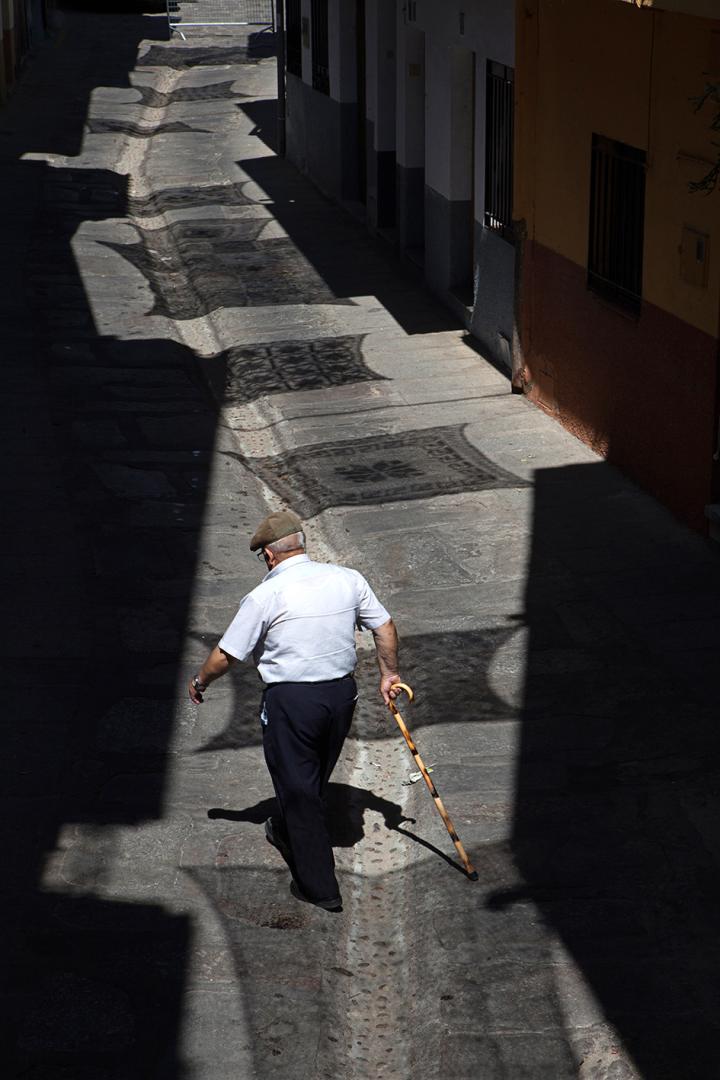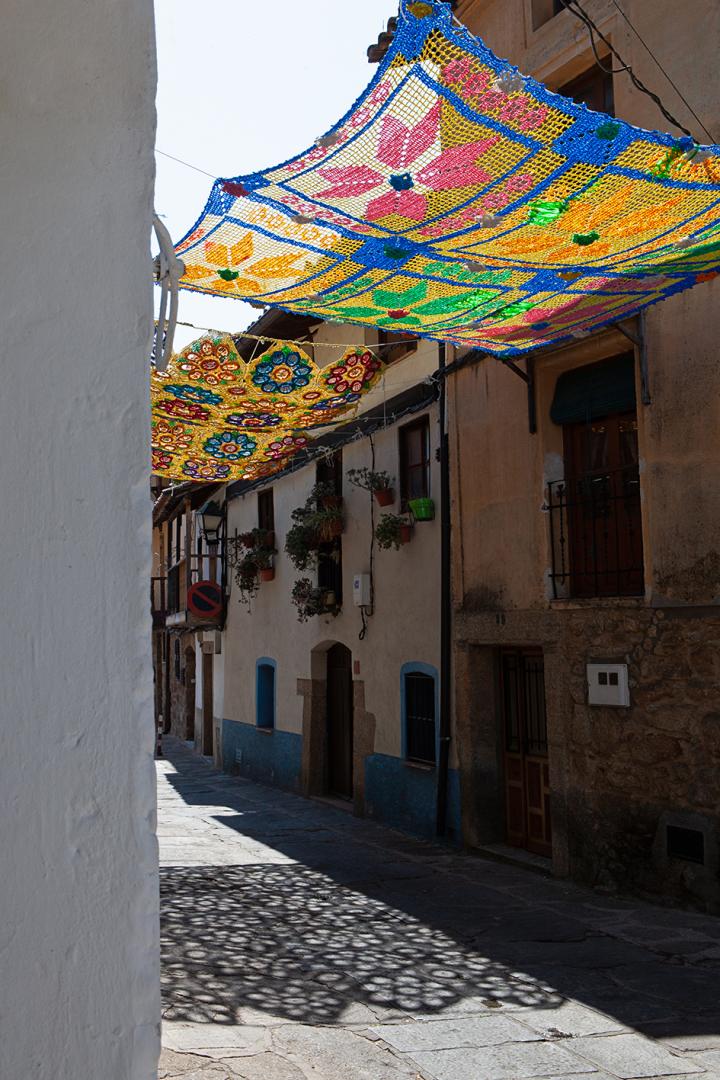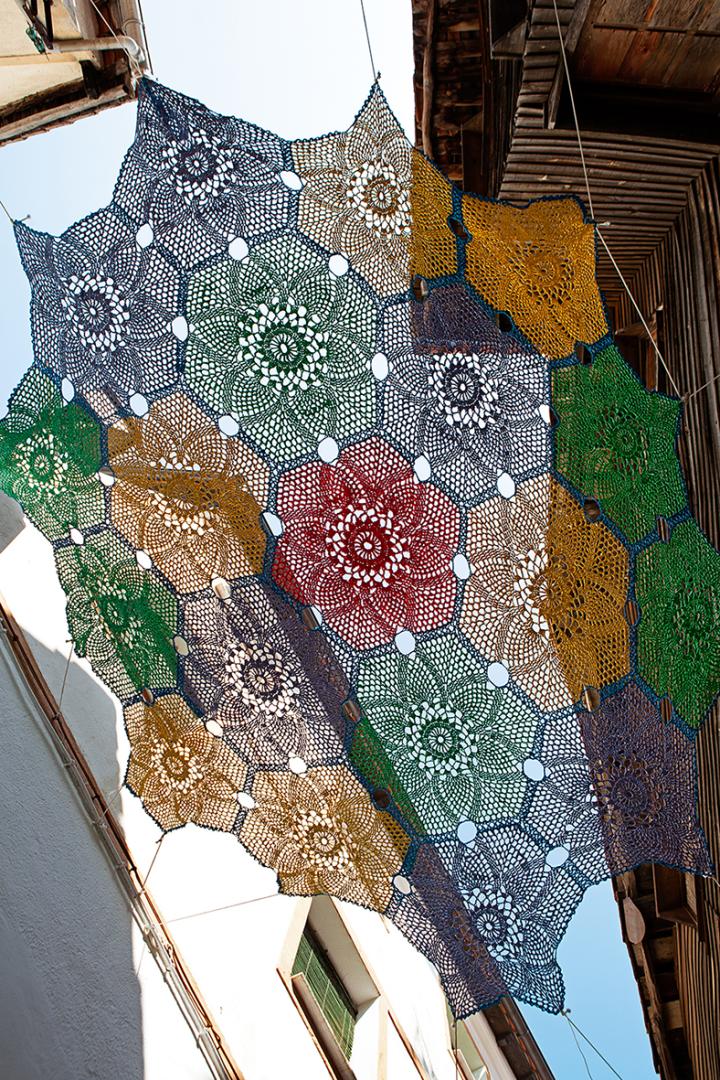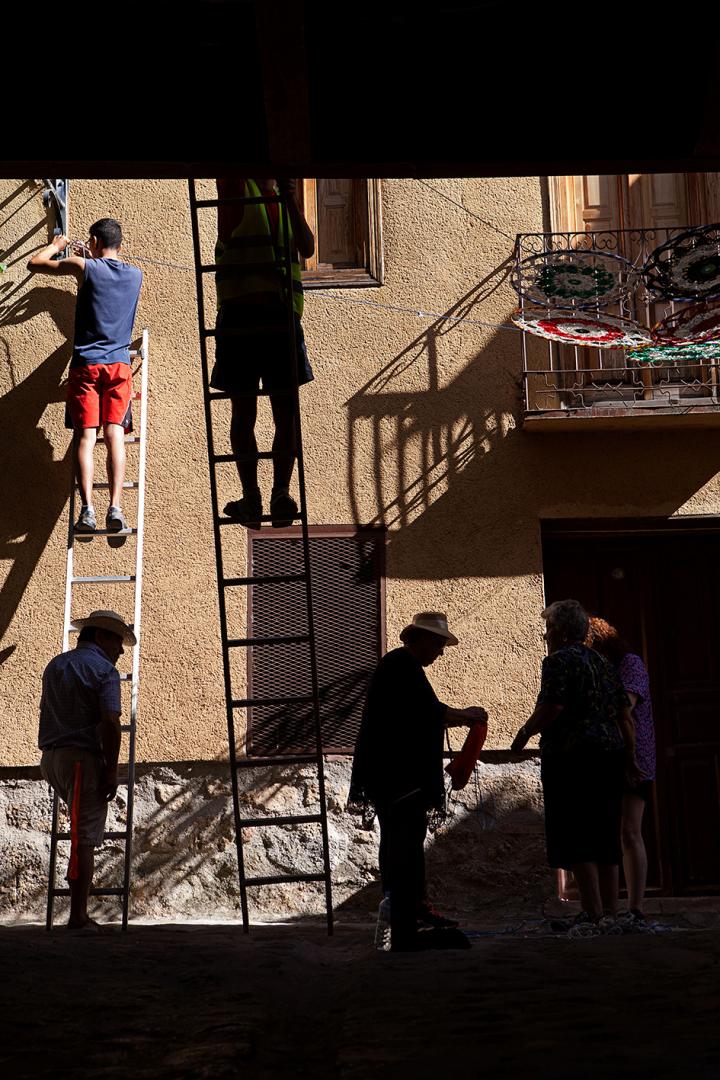Tejiendo la calle
Basic information
Project Title
Full project title
Category
Project Description
Tejiendo la calle is space for cooperation in a rural community. It transforms the streets of the town with light weaved structures as sunshades. The project is done mostly by eldery women who retain and share textile crafts that are being lost. They reuse plastics to crochet the pieces. They generates shadows for the summer with an atmosphere of celebration. They show their affections, wishes and memories. They change every year, and hangs like the clothes between the balconies of the houses.
Project Region
EU Programme or fund
Description of the project
Summary
Tejiendo la calle is a cooperative project. It consists of using “XXL crochet” to create light structures as sunshades, wich are hung througout the streets of Valverde de La Vera (Cáceres, Extremadura, Spain) during the summer. The spatial art installation is an expression of the town´s identity and cultural heritage as well as an embodiment of the intentions and desires of the people who participate in the project. The light structures welcome visitors to the town and help to create a festive atmosphere. They shade people from the sun during the day and show the way to the town´s central square, wich is the main meeting point for people attending the town´s festivities.
The pieces are lightweight and waterproof and can be reused year after year. They are mainly made out of repurposed plastic (shopping, packaging), wich are transformed into long strips that can be crocheted. We also use plastic that we acquire with special colors and greater resistance for remarkable pieces. As well as strings (polypropylene clothesline) to hang the parasols of the street balconies. After several uses, we take the damaged and not repairable parasols to recycle.
The project is open to anyone who wants to participate, regardless of their level of experience. Participants knit their pieces individually or in groups. Meetings are held once a month in the town square, where participants share their experiences and techniques, experts teach beginners, and people show each other their works in progress.
Each person creates his or her own personal design, which will then form part of the group´s larger work. It is important to recognize the textile craft work traditionally done by women in the private sphere for the care of their families and their homes. In Tejiendo la calle, elements linked to the domestic environment are expanded to the public space generating a collective work for the entire community.
Key objectives for sustainability
In terms of sustainability, the key objectives related to materials and techniques applied in Tejiendo la calle are:
According to the current production and consumption dynamics, we could say that crafts are an act of resistance or activism. We reactivate a traditional craft knowledge that is not longer used, linked to the cultural memory of the place: crochet. A textile technique made mostly by women that was transmitted orally from mothers to daughters. Through the project we try to reactivate this disused knowledge, adapting it to the larger scale of public space and to a different material: plastic.
Through the project we try to share conscience about the importance of reusing materials such as plastic, one of the big current environmental pollutants. We save plastic sheets (shopping bags, packagins) that we can reuse to weave our lightweight structures. We extend the life of a waste material, before it is recycled. The parasols are stored to install them year after year, and we also do repair workshops to preserve those that are damaged. We have also introduced other materials, such as fabrics made from recycled PET bottles, obtained from the coast in eastern Spain.
Key objectives for aesthetics and quality
The weaved sunshades have a clear functionality: the improvement of the environmental conditions of the town´s streets by conditioning shady areas. But these pieces not only have a practical function, but also a symbolic one. This ephemeral installation is a self-representation of a rural community. It is manifested through the motifs and ornamental elements that appear in the fabrics. We find elements common to different cultures and also local and personal ones, such as native plants and flowers, animals, also poems, or representations linked to memories of the life in the town. The pieces aesthetics is linked to the popular textile arts, but in a large scale and using different materials. These pieces visualize elements of the collective imaginary of the rural community.
Through this ephemeral installation we experience the public space and the traditional architecture that we inhabit in a different way, and we also try to promote the care of the heritage.
Valverde de la Vera is a small town of 500 inhabitants, which, like many others, suffers the serious damage of depopulation. We do the installation in a very symbolic moment for the town: the summer. It is when family, friends and visitors return. Through our pieces we try to welcome and celebrete them.
Key objectives for inclusion
In this project, the elderly women of a rural community are the protagonists. Through Tejiendo la calle we try to open a space that reinforces the skills for cooperation in a rural community. Our team is made up mostly of older women. It is open to the colaboration of people of any age, promoting intergenerationality. We carry out workshops in which the most expert women show their knowledge to the newest ones. There is an activity in the small town throughout the year that culminates in the public installation in the months of greatest tourist influx.The activity is also done with the youngest in the school and children's camps.
Results in relation to category
Our town is located in Extremadura, a rural area or the west of Spain. It has a traditional valuable architecture heritage, made with local materials like wood and adobe, and a rich biodiversity and nature environment. But depopulation, the non-existence of work for younger people who emigrates to cities, and the ageing of the population, among other reasons, show the necesity of reflect and act about the future of our towns. Through collaborative art projects like Tejiendo la calle it is possible to transform the way we relate with the space we inhabit. Through the project we reinforce the meeting in the town´a public space. Weavers meet usually (once a month in not covid times) in the main square of the town to share the work done. When the artistic spatial installation is hung up, It is an invitation to walk throug the streets of the town. We change the position of the parasols every year to promote comunitary sense, and also to engage people to visit the places of the town that are less usual or are hidden.
How Citizens benefit
We started the project in 2013, and we have been doing it every year since then. We promote meeting in the public space and the social cohesion. We do a hand-made production process, in which the people weave elements that are exposed and transform the shared space of their town. The initiative makes it easy to connect with your neighbors through a creative and collective process. We share a positive affection for the town. The act of taking part, getting involved, and do something physical throug a creative process increase of the self-esteem of the participants and the entire community. The project has been assumed as a valuable tradition in the town, as a ritual that is part of its landscape every year.
Innovative character
Through the project, we try to decentralize a street art or public art initiative to a rural context where there are not so usual, democratizing the access to contemporary cultural projects. Our work could be framed as social engaged art, interventions in public space and craftivism. We try to work with the local knowledge and empower eldery women of the town. We also try to reinforce cooperation skills and to create links and reflections about the environmet and the landscape we inhabit.

